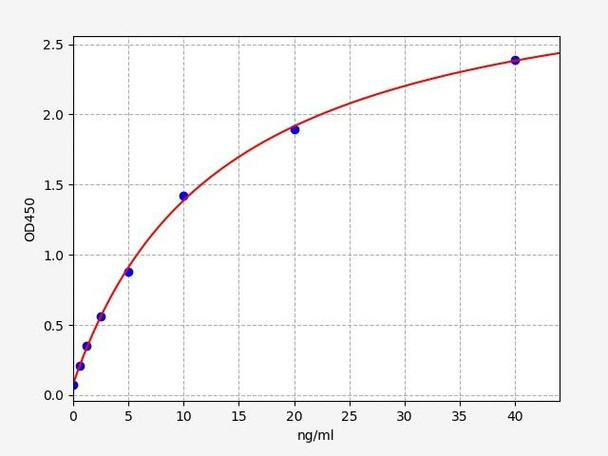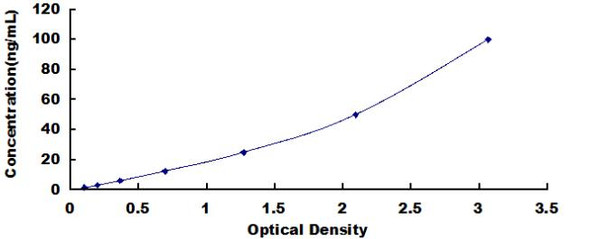Description
Rat Adh1/Alcohol dehydrogenase 1 ELISA Kit
The Rat ADH1 (Alcohol Dehydrogenase 1) ELISA Kit is specifically designed for the accurate and sensitive detection of ADH1 levels in rat serum, plasma, and cell culture supernatants. This kit offers high precision and reliability, ensuring consistent and reproducible results for a variety of research applications.ADH1 is an important enzyme involved in the metabolism of alcohol, playing a key role in the breakdown of ethanol in the liver. Dysregulation of ADH1 has been linked to various liver diseases and alcohol-related disorders, making it a valuable biomarker for studying these conditions and developing potential therapeutic interventions.
With its high sensitivity and specificity, the Rat ADH1 ELISA Kit provides researchers with a powerful tool for investigating the role of ADH1 in physiology and pathology, offering valuable insights into liver health and alcohol metabolism in rat models.
| Product Name: | Rat Adh1 (Alcohol dehydrogenase 1) ELISA Kit |
| Product Code: | RTFI00226 |
| Size: | 96 Assays |
| Target: | Rat Adh1 |
| Alias: | Adh1, Adh-1, Alcohol dehydrogenase A subunit, Alcohol dehydrogenase 1 |
| Reactivity: | Rat |
| Detection Method: | Sandwich ELISA, Double Antibody |
| Sensitivity: | 0.375ng/ml |
| Range: | 0.625-40ng/ml |
| Storage: | 4°C for 6 months |
| Note: | For Research Use Only |
| Recovery: | Matrices listed below were spiked with certain level of Rat Adh1 and the recovery rates were calculated by comparing the measured value to the expected amount of Rat Adh1 in samples. | ||||||||||||||||
| |||||||||||||||||
| Linearity: | The linearity of the kit was assayed by testing samples spiked with appropriate concentration of Rat Adh1 and their serial dilutions. The results were demonstrated by the percentage of calculated concentration to the expected. | ||||||||||||||||
| |||||||||||||||||
| Intra-Assay: | CV <8% | ||||||||||||||||
| Inter-Assay: | CV <10% |
| Uniprot: | P06757 |
| UniProt Protein Function: | ADH1A: a member of the alcohol dehydrogenase family. The encoded protein is the alpha subunit of class I alcohol dehydrogenase, which consists of several homo- and heterodimers of alpha, beta and gamma subunits. Alcohol dehydrogenases catalyze the oxidation of alcohols to aldehydes. This gene is active in the liver in early fetal life but only weakly active in adult liver. This gene is found in a cluster with six additional alcohol dehydrogenase genes, including those encoding the beta and gamma subunits, on the long arm of chromosome 4. Mutations in this gene may contribute to variation in certain personality traits and substance dependence. [provided by RefSeq, Nov 2010] |
| UniProt Protein Details: | Protein type:Amino Acid Metabolism - tyrosine; Carbohydrate Metabolism - glycolysis and gluconeogenesis; Cofactor and Vitamin Metabolism - retinol; EC 1.1.1.1; Lipid Metabolism - fatty acid; Oxidoreductase; Transcription regulation; Xenobiotic Metabolism - drug metabolism - cytochrome P450; Xenobiotic Metabolism - metabolism by cytochrome P450 Chromosomal Location of Human Ortholog: 2q44 Cellular Component: cytosol; intracellular; mitochondrion; nucleoplasm; plasma membrane Molecular Function:alcohol dehydrogenase activity; alcohol dehydrogenase activity, zinc-dependent; drug binding; ethanol binding; NAD binding; protein homodimerization activity; retinol dehydrogenase activity Biological Process: acetaldehyde biosynthetic process; behavioral response to ethanol; ethanol catabolic process; ethanol oxidation; organ regeneration; response to progesterone stimulus; response to retinoic acid; response to steroid hormone stimulus; response to testosterone stimulus; retinoic acid metabolic process; retinoid metabolic process; retinol metabolic process |
| NCBI Summary: | alpha subunit of class I alcohol dehydrogenase; metabolizes a wide variety of substrates including ethanol, hydroxysteroids and lipid peroxidation products [RGD, Feb 2006] |
| UniProt Code: | P06757 |
| NCBI GenInfo Identifier: | 158081755 |
| NCBI Gene ID: | 24172 |
| NCBI Accession: | NP_062159.3 |
| UniProt Related Accession: | P06757 |
| Molecular Weight: | 39,645 Da |
| NCBI Full Name: | alcohol dehydrogenase 1 |
| NCBI Synonym Full Names: | alcohol dehydrogenase 1 (class I) |
| NCBI Official Symbol: | Adh1 |
| NCBI Official Synonym Symbols: | Adh; Adh1a; Adh1c |
| NCBI Protein Information: | alcohol dehydrogenase 1 |
| UniProt Protein Name: | Alcohol dehydrogenase 1 |
| UniProt Synonym Protein Names: | Alcohol dehydrogenase A subunit |
| Protein Family: | Alcohol dehydrogenase |
| UniProt Gene Name: | Adh1 |
| Step | Procedure |
| 1. | Set standard, test sample and control (zero) wells on the pre-coated plate respectively, and then, record their positions. It is recommended to measure each standard and sample in duplicate. Wash plate 2 times before adding standard, sample and control (zero) wells! |
| 2. | Aliquot 0.1ml standard solutions into the standard wells. |
| 3. | Add 0.1 ml of Sample / Standard dilution buffer into the control (zero) well. |
| 4. | Add 0.1 ml of properly diluted sample ( Human serum, plasma, tissue homogenates and other biological fluids.) into test sample wells. |
| 5. | Seal the plate with a cover and incubate at 37°C for 90 min. |
| 6. | Remove the cover and discard the plate content, clap the plate on the absorbent filter papers or other absorbent material. Do NOT let the wells completely dry at any time. Wash plate X2. |
| 7. | Add 0.1 ml of Biotin- detection antibody working solution into the above wells (standard, test sample & zero wells). Add the solution at the bottom of each well without touching the side wall. |
| 8. | Seal the plate with a cover and incubate at 37°C for 60 min. |
| 9. | Remove the cover, and wash plate 3 times with Wash buffer. Let wash buffer rest in wells for 1 min between each wash. |
| 10. | Add 0.1 ml of SABC working solution into each well, cover the plate and incubate at 37°C for 30 min. |
| 11. | Remove the cover and wash plate 5 times with Wash buffer, and each time let the wash buffer stay in the wells for 1-2 min. |
| 12. | Add 90 µL of TMB substrate into each well, cover the plate and incubate at 37°C in dark within 10-20 min. (Note: This incubation time is for reference use only, the optimal time should be determined by end user.) And the shades of blue can be seen in the first 3-4 wells (with most concentrated standard solutions), the other wells show no obvious color. |
| 13. | Add 50 µL of Stop solution into each well and mix thoroughly. The color changes into yellow immediately. |
| 14. | Read the O.D. absorbance at 450 nm in a microplate reader immediately after adding the stop solution. |
When carrying out an ELISA assay it is important to prepare your samples in order to achieve the best possible results. Below we have a list of procedures for the preparation of samples for different sample types.
| Sample Type | Protocol |
| Serum: | If using serum separator tubes, allow samples to clot for 30 minutes at room temperature. Centrifuge for 10 minutes at 1,000x g. Collect the serum fraction and assay promptly or aliquot and store the samples at -80°C. Avoid multiple freeze-thaw cycles. If serum separator tubes are not being used, allow samples to clotovernight at 2-8°C. Centrifuge for 10 minutes at 1,000x g. Removeserum and assay promptly or aliquot and store the samples at-80°C. Avoid multiple freeze-thaw cycles. |
| Plasma: | Collect plasma using EDTA or heparin as an anti-coagulant. Centrifuge samples at 4°C for 15 mins at 1000 × g within 30 mins of collection. Collect the plasma fraction and assay promptly or aliquot and store the samples at -80°C. Avoid multiple freeze-thaw cycles.Note: Over haemolysed samples are not suitable for use with this kit. |
| Urine & Cerebrospinal Fluid: | Collect the urine (mid-stream) in a sterile container, centrifuge for 20 mins at 2000-3000 rpm. Remove supernatant and assay immediately. If any precipitation is detected, repeat the centrifugation step. A similar protocol can be used for cerebrospinal fluid. |
| Cell Culture Supernatant: | Collect the cell culture media by pipette, followed by centrifugation at 4°C for 20 mins at 1500 rpm. Collect the clear supernatant and assay immediately. |
| Cell Lysates: | Solubilize cells in lysis buffer and allow to sit on ice for 30 minutes. Centrifuge tubes at 14,000 x g for 5 minutes to remove insoluble material. Aliquot the supernatant into a new tube and discard the remaining whole cell extract. Quantify total protein concentration using a total protein assay. Assay immediately or aliquot and store at ≤ -20°C. |
| Tissue Homogenates: | The preparation of tissue homogenates will vary depending upon tissue type. Rinse tissue with 1X PBS to remove excess blood & homogenizein 20ml of 1X PBS (including protease inhibitors) and store overnight at ≤ -20°C. Two freeze-thaw cycles are required to break the cell membranes. To further disrupt the cell membranes you can sonicate the samples. Centrifuge homogenates for 5 mins at 5000xg. Remove the supernatant and assay immediately or aliquot and store at -20°C or-80°C. |
| Tissue Lysates: | Rinse tissue with PBS, cut into 1-2 mm pieces, and homogenize with a tissue homogenizer in PBS. Add an equal volume of RIPA buffer containing protease inhibitors and lyse tissues at room temperature for 30 minutes with gentle agitation. Centrifuge to remove debris. Quantify total protein concentration using a total protein assay. Assay immediately or aliquot and store at ≤ -20 °C. |
| Breast Milk: | Collect milk samples and centrifuge at 10,000 x g for 60 min at 4°C. Aliquot the supernatant and assay. For long term use, store samples at -80°C. Minimize freeze/thaw cycles. |






